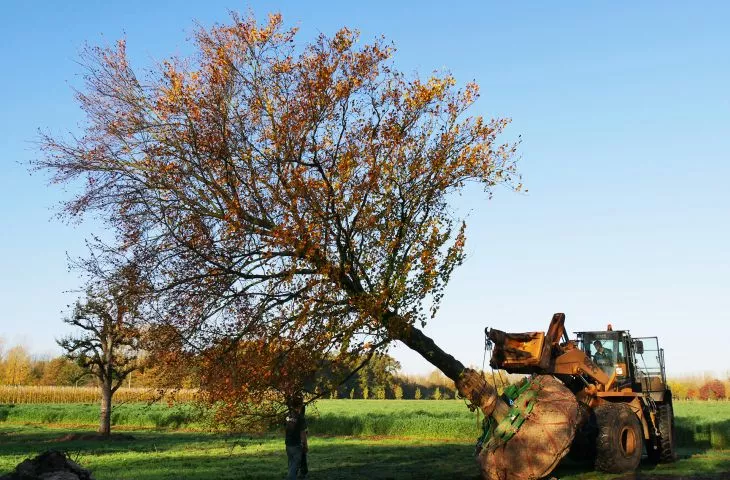The problem of betonosis in Polish cities
In recent years, the problem of removing trees in city centers has become clearly evident. If we were to ask random people on the street whether trees are badly needed in the city, surely most would answer yes - on this, as a society, we agree. Nevertheless, there is always some reason to remove them irrevocably in investment processes. The problem of concreting, which currently appears in Polish cities, concerns both public spaces subject to local governments or the state, as well as those commercial or private.
what do trees in the city provide?
Lack of trees is not just empty space. Trees give us many benefits that we often don't realize. Mature specimens, especially in dense groups, lower the temperature and eliminate heat islands. They are refuges for animals and an element of biodiversity, or the creation of an important urban nature ecosystem for humans. It is impossible to forget about the aesthetics of the space and the mental balance resulting from their presence.
However, these aspects, which are not visible to the naked eye and are difficult to convert into a concrete financial value, are not able - as you can see - to defend trees from being cut down.
The aforementioned factors in our perception do not convert directly into parking lots, PUMAs, or wider roads. Therefore, they are not a value that is taken into account in construction processes and investments in the city. It is because of this approach that large trees are, in the "best" case, irrevocably moved from the city center, and in the worst case - they end their lives.
This problem is already noticeable in many cities, and public awareness of it is growing. The shrinking tree canopy in the center of cities is no longer brought to the attention of not only whistleblowers or urban activists, but also ordinary residents who are not entirely comfortable with living only surrounded by concrete.
ready for transport
photo: © Landscapes Foundation
why do we get rid of trees so easily?
As a landscape architect, for many years I have been trying to figure out what is the reason for such a large and aggressive interference with tall greenery. Why is it that in the processes of creating new developments, one of the main (though often unconsciously made) assumptions is to remove trees without thinking about their adaptation, or looking for other equivalent solutions?
In my opinion, in addition to city-forming processes - those whose overriding value is the monetization of investments, usable space or parking spaces - an important factor that contributes to the removal of trees is the short timeframe for planning and implementation of investments. This does not translate into a problem directly, but is linked to external investment funding, where application deadlines do not allow documentation to be developed with thought and consideration. This is why the most spectacular revitalizations of markets or central squares in many cities take place in such a drastic way for trees. This is compounded by another factor: in conservation areas, planners explain the cuttings by conservationist guidelines.
It is also noticeable that when protests occur, local government officials and those in charge of investments explain that there was no other solution, that the trees had to be removed for traffic routes, bicycle paths or urban density. This is accompanied by assurances about compensatory plantings as part of planned cutting in another part of the city. Such justification of the situation should not take place - trees planted in compensation do not generate the same ecological and aesthetic benefits as adult specimens. One large tree removed from the center is offset - according to the study - by more than 1,000 seedlings with a circumference of 10-12 cm.
There is no room in the city for this amount of new plantings, and on the other hand, there is also a lack of formalized conversion rates. This is done on a piece-for-piece basis, only that art with a small trunk circumference will reach its maturity (if at all) in a few decades. So it's surprising that we pass over this, and the formal "penalty" amount of tens of thousands of zlotys for permission to cut down a tree is exchanged for planting a tree with a value of 500 zlotys and a diameter of, say, 16 cm.
These are the main problems that arise in discussions. However, I believe that it is necessary to penetrate deeper into the investment process and start a discussion as soon as possible on how to counteract the worsening problem of removing trees from the fabric of the city.The topic should not be raised (as is often the case) only at the point where saws are already heard, or residents protest in the streets, and investors or local government officials explain that "nothing can be done now" possibly looking for substitute solutions (for example, in the form of digging up trees "on the fly" and trying to move them to other places). Then it's really too late, and stock actions of relocating trees are not effective solutions, because the trees disappear irretrievably - just like those cut down.
planting a tree
Photo: Van Den Berk
"the mayor's fault"
"The fault of the mayor" - This is what I call the moment when the media get into the act, and local government officials or investors explain the situation in various ways. The problem often lies elsewhere and at a different stage of the investment processes, other than the preparation of the site for the start of construction work (which entails logging). This stage is the awareness of designers, investment engineers or those responsible for procurement at the very beginning of the investment process. This is where changes need to be made, and this is where you need to be sensitive to trees and related activities.
One such factor is the awareness that in place of trees being cut down, we can plant in markets, squares or next to commercial and residential buildings, not 10- or 12-centimeter saplings, but mature specimens.
It is enough to include in the project documentation, investment documentation, STWiORB, investor's cost estimate (and therefore a blind cost estimate) mature trees of 50 or 70 cm and appropriate provisions for planting and supporting infrastructure. The same applies to the provisions of the ToR for public procurement, and we can change the picture of the entire investment.
Lack of awareness that there are such large trees to plant contributed to the fact that we started the "Big Trees for Cities" project as part of the activities of the Landscapes Foundation.
We have held a number of workshops and presentations, as well as webinars to introduce the issue. We try to change the awareness of planting large trees among all participants in construction investment processes. At our meetings we show how it is possible to plant, to include in projects or investment documentation specimens with sizes much larger than those we are used to. It is then much easier to go through the investment process, and the trees are simply replaced (for health, compositional or infrastructural reasons), rather than removed irrevocably. As a foundation, we have already implemented both in the fabric of public space, commercial space or private investors.
Planting a large tree as part of the Urban Lab for the city of Leczna
Photo: © Landscapes Foundation
Someone once made a big educational mistake, showing us that trees have stilted root systems or masses spread to a very large extent, and thus it is not possible to plant large specimens. This myth persists to this day and appears in many conversations, making it impossible to accelerate change. Trees that are properly prepared have root balls that are suitable even for transportation by an ordinary TIR. The second factor that comes up in discussions is the problem of the amount of money that needs to be spent on large seedlings. The value of one tree is several thousand zlotys, or the equivalent of several tens of square meters of paving stones - I often mention this during workshops. Therefore, for investments worth several million or even several hundred thousand, making plantings from large trees is not an element of mismanagement or a factor that significantly disturbs the value of the investment. Thus, awareness and knowledge of technology is enough to implement these measures. As I mentioned, trees can also be accompanied by technology that allows them to grow and develop properly, without interfering with underground infrastructure or pavements. Anti-compaction systems or systems that direct roots so that they do not negatively affect other facilities are available. Meanwhile, we stopped in our designs at only three stakes surrounding the sapling included in the specifications and the plant's Latin name. This is the rationale behind the changes that should be made in the investment and design process. Designers of all trades should consider implementing modern solutions in this area as well (just as they do in cubicles) - ones that will work with the idea of equivalent treatment of all components of the designed objects, including landscaping.
Reviewing design documents, tenders or requests for proposals for architectural objects in recent years, there is a noticeable lack of thought in matters of trees. It is worth fighting this pattern, creating documentation comprehensively, with the awareness that responsible design, so fashionable nowadays, is not only eco materials, zero-energy, or technologies such as green roofs or walls that increase the biologically active area. It's also landscaping, in which trees and their function play a big role. The situation also applies to the design of traffic routes such as avenues, promenades, roadways or pedestrian routes. Let's remember that every time we make a decision from behind our desk to remove a tree, we should think about compensation, which will really be compensation and not a formal fix.
This is part of responsible design.
So much for investment processes, although there is another value in planting large trees - the aesthetic and visual aspect. Maybe he will convince architects or developers. Planting large trees will have the same effect as a building. Immediately in landscaping we will get what we call fullness of happiness. Today, a building, once erected, has to wait, as it were, for the landscaping to come together to achieve the effect that the architect envisioned when creating the sales visuals. Nowadays, we often have to wait many years for this image.
In conclusion, I currently see no contraindication to directing the activities of designers beyond stereotypes and established patterns. I think that it will not be possible to introduce formal-legal provisions for changing the parameters of compensatory plantings in the near future. Therefore, a large role in combating climate change in urban areas should be played by participants in construction investment processes, including informed and responsible designers, who, on the one hand - by planting large trees - will contribute to reducing the heat island, and on the other hand will achieve the intended aesthetic effect more quickly. One that we would like to see from the beginning and still in our lifetime.
We all know that a good view from a window costs money. Planting large trees therefore also has an economic dimension.
Wojciech Januszczyk
Wojciech Januszczyk - landscape architect, employee of the Institute of Landscape Architecture of the Catholic University of Lublin, founder of the Landscapes Foundation, Supervisor of Green Areas and expert witness. Originator and artistic director of the festival of art of gardens and spaces - InGarden. He served as president of the National Association of Landscape Architecture, on whose behalf he signed Poland's accession to the Worldwide Federation of Landscape Architecture (IFLA) in 2008. He and his design team have won a number of awards in competitions for public and commercial spaces. Creator of the "Garden of Dream" realized as part of the exhibition Green is Life supporting the activities of the Ewa Blaszczyk Foundation "AKOGO?". Participant of the Festival of Gardens in Bolestraszyce, where he creates author's realizations of gardens under the cyclical title "Protest Garden", drawing public attention to contemporary problems related to space and landscape of the country. His commercial activities are guided by the author's idea of "Garden is also a home" indicating the functional nature of the space next to single-family houses. He has experience in directing and managing investment processes during the implementation of landscape architecture facilities, including the construction of home gardens, historic parks and public spaces.









































